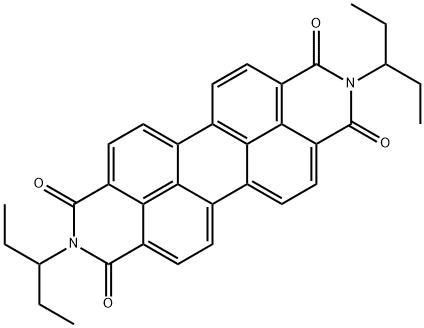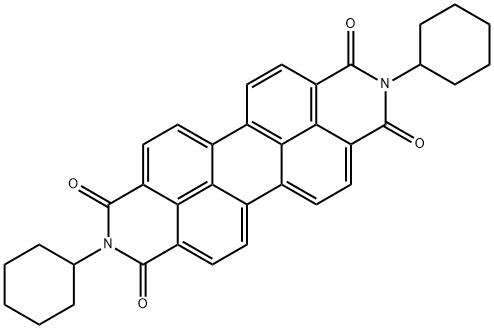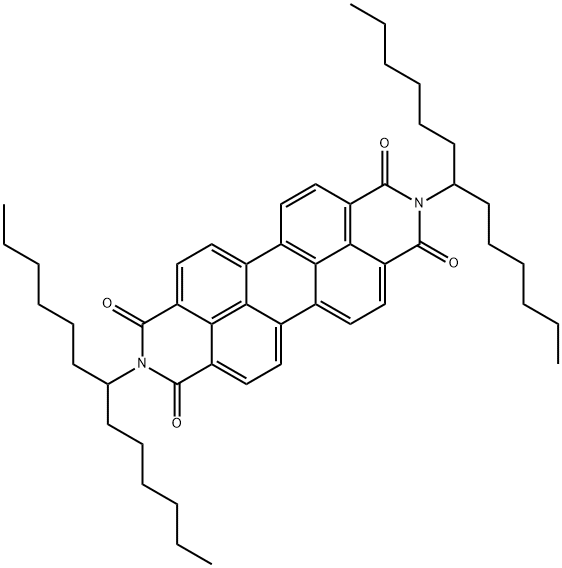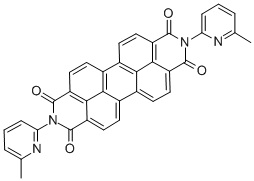2,9-Di(pent-3-yl)anthra2,1,9-def:6,5,10-d'e'f'diisoquinoline-1,3,8,10-tetrone
Synonym(s):N,N′-Bis(ethylpropyl)perylene-3,4,9,10-tetracarboxylicdimide;N,N-Bis(ethylpropyl)perylene-3,4,9,10-tetracarboxylicdiimide;2,9-Di(pent-3-yl)-anthra[2,1,9-def,6,5,10-d′e′f′]diisoquinoline-1,3,8,10-tetrone;Anthra[2,1,9-def:6,5,10-d′e′f′]diisoquinoline-1,3,8,10(2H,9H)-tetrone, 2,9-bis(1-ethylpropyl)-;PBI
- CAS NO.:110590-81-3
- Empirical Formula: C34H30N2O4
- Molecular Weight: 530.61
- MDL number: MFCD00799275
- SAFETY DATA SHEET (SDS)
- Update Date: 2023-06-08 08:28:36

What is 2,9-Di(pent-3-yl)anthra2,1,9-def:6,5,10-d'e'f'diisoquinoline-1,3,8,10-tetrone?
The Uses of 2,9-Di(pent-3-yl)anthra2,1,9-def:6,5,10-d'e'f'diisoquinoline-1,3,8,10-tetrone
EP-PDI (acceptor) blended with P3HT (donor) and PCBM (donor) can be used in the fabrication of organic photovoltaic devices and organic solar cells. It forms a mixture with tetrahydrofuran (THF) that shows high intensity fluorescence which can be used as a sensor for the detection of nitroaromatic compounds.
General Description
N,N′-Bis(3-pentyl)perylene-3,4,9,10-bis(dicarboximide) (EP-PDI) is a perylenediimide derivative that has a planar backbone and π-conjugation. It is a thermally stable polymer with luminescence and photochemical properties. It acts as a pigment and has charge mobility of 1 cm2V-1s-1 which can be used in a variety of energy and chemical sensing based applications.
Properties of 2,9-Di(pent-3-yl)anthra2,1,9-def:6,5,10-d'e'f'diisoquinoline-1,3,8,10-tetrone
| Melting point: | >450°C |
| Boiling point: | 724.1±33.0 °C(Predicted) |
| Density | 1.351±0.06 g/cm3(Predicted) |
| storage temp. | 2-8°C |
| pka | -2.33±0.20(Predicted) |
| form | powder |
Safety information for 2,9-Di(pent-3-yl)anthra2,1,9-def:6,5,10-d'e'f'diisoquinoline-1,3,8,10-tetrone
| Signal word | Warning |
| Pictogram(s) |
 Exclamation Mark Irritant GHS07 |
| GHS Hazard Statements |
H315:Skin corrosion/irritation H319:Serious eye damage/eye irritation H335:Specific target organ toxicity, single exposure;Respiratory tract irritation |
| Precautionary Statement Codes |
P261:Avoid breathing dust/fume/gas/mist/vapours/spray. P264:Wash hands thoroughly after handling. P264:Wash skin thouroughly after handling. P271:Use only outdoors or in a well-ventilated area. P280:Wear protective gloves/protective clothing/eye protection/face protection. P302+P352:IF ON SKIN: wash with plenty of soap and water. P305+P351+P338:IF IN EYES: Rinse cautiously with water for several minutes. Remove contact lenses, if present and easy to do. Continuerinsing. |
Computed Descriptors for 2,9-Di(pent-3-yl)anthra2,1,9-def:6,5,10-d'e'f'diisoquinoline-1,3,8,10-tetrone
New Products
Tert-butyl bis(2-chloroethyl)carbamate (S)-3-Aminobutanenitrile hydrochloride N-Boc-D-alaninol N-BOC-D/L-ALANINOL N-octanoyl benzotriazole 4-Hydrazinobenzoic acid 3,4-Dibenzyloxybenzaldehyde Electrolytic Iron Powder 1,1’-CARBONYLDIIMIDAZOLE R-2-BENZYLOXY PROPIONIC ACID 4-HYDROXY BENZYL ALCOHOL 1,1’-CARBONYLDI (1,2-4 TRIAZOLE) S-2-CHLORO PROPIONIC ACID (2-Hydroxyphenyl)acetonitrile 4-Bromopyrazole 5-BROMO-2CYANO PYRIDINE 5,6-Dimethoxyindanone 5-broMo-2-chloro-N-cyclopentylpyriMidin-4-aMine 3-(2,4-Dimethoxybenzyl)dihydropyrimidine-2,4(1H,3H)-dione 6-Bromo-3-iodo-1-methyl-1H-indazole 4-Ethylbenzylamine N-(5-Amino-2-methylphenyl)acetamide 2-(BOC-Amino)4-picoline 1-(4-Methylphenylsulfonyl)-1H-1,2,3-benzotriazoleRelated products of tetrahydrofuran

![2,9-DI(CYCLODECYL)-ANTHRA[2,1,9-DEF:6,5,10-D'E'F']DIISOQUINOLINE-1,3,8,10-TETRONE](https://img.chemicalbook.in/StructureFile/ChemBookStructure4/GIF/CB2233921.gif)



You may like
-
 N,N′-Bis(3-pentyl)perylene-3,4,9,10-bis(dicarboximide) CAS 110590-81-3View Details
N,N′-Bis(3-pentyl)perylene-3,4,9,10-bis(dicarboximide) CAS 110590-81-3View Details
110590-81-3 -
 100-71-0 99%View Details
100-71-0 99%View Details
100-71-0 -
 2 2-BIS(2-HYDROXYETHOXY)-1 1-BINAPHTHYL 99%View Details
2 2-BIS(2-HYDROXYETHOXY)-1 1-BINAPHTHYL 99%View Details
55441-95-7 -
 Chloro Uracil 1820-81-1 99%View Details
Chloro Uracil 1820-81-1 99%View Details
1820-81-1 -
 2-ethyl-6-methyl-3-hydroxypyridine succinate 127464-43-1 99%View Details
2-ethyl-6-methyl-3-hydroxypyridine succinate 127464-43-1 99%View Details
127464-43-1 -
 13162-05-5 N-Vinylformamide 99%View Details
13162-05-5 N-Vinylformamide 99%View Details
13162-05-5 -
 1446013-08-6 98%View Details
1446013-08-6 98%View Details
1446013-08-6 -
 Ste-Glu-AEEA-AEEA-OSUView Details
Ste-Glu-AEEA-AEEA-OSUView Details
1169630-40-3
Statement: All products displayed on this website are only used for non medical purposes such as industrial applications or scientific research, and cannot be used for clinical diagnosis or treatment of humans or animals. They are not medicinal or edible.